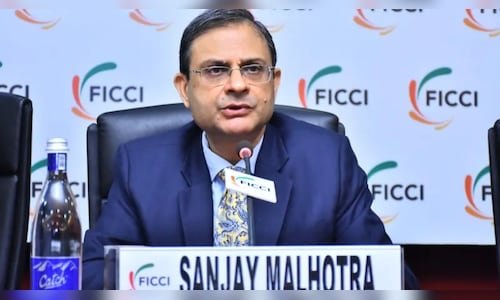
He noted that while there has been some adjustment in expectations, particularly regarding the timing of a potential rate cut—shifting from September or December to February—there have been no significant changes in the overall business environment. The fundamental outlook for these sectors remains stable.
Chakrabarti also emphasised that margins typically bottom out after rate cuts, as a large portion of the loan book is linked to repo rates, and a greater share will follow once rates are reduced. As top corporate loans shift to the lowest rates, margins will stabilise and slightly improve, setting the stage for strong earnings growth in 2025-26 (FY26).
This is the edited excerpt of the interview.
Q: How does BFSI figure for BNP Paribas, should we even chase banks, or should we really wait for even six more months for liquidity to return and banks to get more comfortable?
A: The BNP Paribas view throughout the last year has been, that we have preferred banks, and IT is what our strategist Kunal has preferred. Within banks, not much has fundamentally changed. Maybe in the beginning of the year, if we would have thought about a September or December cut, and now we are talking about a February cut. But other than that, if you look at the overall setup of the business, nothing has really changed.
Q: Have deposits costs peaked, have margins bottomed, or you think there is more of margin erosion left to come, and for how many quarters?
A: The answer to that is, as far as our pre-cut basis is concerned, both of those things have happened in a material sense. I mean, one two basis points together is different, because what were the costs hardening from the costs were essentially hardening from the repricing of the FD-backed book, now that is done. If you are look at the existing FD books of banks, what their implied yields look like and the incremental pricing on which they are raising FDs, they are both at par. So incrementally, the only pressure on cost of funds is the extent to which FDs increase in proportion of total funds. That’s about it and hat’s a couple of basis points here and there.
What happens is margins actually bottom after rate cuts. Because, remember, a very large part of the loan book is repo linked and slightly larger part will become repo linked the moment rates get cut. We are talking about top corporate exposures, which will go to the lowest rate so the margins bottom after that, from that point onwards, you are stable to slightly improving margins, which creates a great earnings growth set up for 2025-26.
Read Here | HDFC Bank shares are the second-biggest contributors to the Nifty 50 fall post Q3 update
Q: HDFC Bank, it’s not the one that’s lost the most, but willy-nilly even if it is in the red, it pulls the Bank Nifty a goodish bit. What have you made of the numbers? 3% loan growth is after having sold off ₹46,000 crore of loans this year. Otherwise the number would have been different?
A: Otherwise, also on their base, the number doesn’t look blazingly different. And frankly, the loan sell downs tell us more about their approach towards profitability and pricing consciousness, rather than have a material impact on the size of the balance sheet at this point. This was true of the mortgage sales that they did in the first half, and it remains true even at the end of the third quarter. But gives us a sense that they are very cautious, that the money that they are raising incrementally is high cost money, and therefore the asset uses it should be put into should be commensurate to the cost of that money and the nature of that money.
So, for example, in this quarterly release, also you will see the growth has been primarily in what they call CRB – commercial and rural banking and retail; and wholesale which is corporate, essentially still continues in shrinkage mode. Having said that is 0.9% quarter-on-quarter, a low number, no doubt about it.
Q: What do you expect their margins to be? My sense is the margins are going to be as good or better than the previous quarter. But ultimately, EPS, or profit, is both volume and value so margins are high, but volume is going to be low. What is your EPS forecast, ROE — how do you approach the bank?
A: In this part of the interest rate cycle, the cost of funds for most banks have kind of matured, so margin erosion to start with, which drifts down into ROE is not material for any of the major banks. HDFC is a special case where HDFC because of a very somewhat irregular liability structure that it’s coming off, and it’s gradually rationalising, you might actually see even better performance on a sequential basis, on margins vis-à-vis other banks. The moment, you see that they have been able to move deposits up by 2.5% sequentially not a large number, but a meaningful number, ₹64,000 crore number is not small in the context of what’s happened in the system in the last quarter, especially in December.
In that context, the margin surprise, which the market reacted so positively to last quarter, that positive margin surprise could come. Now I hear your point around how profits are ultimately a function of both loan growth as well as margins, but I think in HDFC case, especially if people have a price to book prism on valuations, they are trying to figure out what steady state margins and therefore ROAs and ROEs look like. And better and improved optics on that on a sequential basis, I think it’s going to weigh heavier than what the EPS number looks like.
Read Here | Union Bank of India shares fall 7% after weakest business update so far amongst all lenders
Q: What would your price to book forecast be for the year and I think you have the biggest price target on this street, ₹2,550?
A: Look, I have still some way to go before re-rating it back to what it used to trade at, but I am just saying that at 2-2.1 times price to book it is probably, if you strip out the subsidiaries, it’s probably trading at a valuation that better suits a wholesale lending NBFC than a retail dominant bank, even if it’s with low current account savings account (CASA). Therefore, my target multiple is around 2.8, and that gives you that much of upside. I think the path to achievement of that multiple is that margin improvement and therefore consequent impact on ROE.
Q: More generally what have you taken away from all the other private sector banks? We don’t have too many of them. We have got IndusInd Bank, RBL Bank, CSB Bank many of them are smaller banks. The big Axis Bank, ICICI Bank are not out. But what have you made of the private banks?
A: The one which stood out for me was IndusInd Bank. I can understand there’s some stress in the MFI sector, and it’s hard to make a segment commentary at this stage from the early releases, but the numbers on both assets as well as liabilities looked a little lackluster, to be honest. Bank of Baroda has also put out numbers today, and their growth is about 9.50%. The previous anchor was also speaking about Union Bank, their numbers have not looked great.
So overall, I think the tightness of liquidity is starting to bear down on deposit growth. But what is quite interesting is at least the CD ratio aspect of it is no longer a topic that seems to be in play. Because if you look at the last fortnight’s disclosure, you will see the loan growth and deposit growth, as we had expected, has exactly converged to 11.50%. I think easier liquidity is required.
Q: Any PSU bank you like?
A: State Bank of India (SBI) we have just gone to neutral because pricing appears a little more full to us at this stage, but we like the setup. There’s nothing wrong there, as far as we are concerned from a business perspective. But just that, relative to what we have available on things like HDFC Bank at this point, we have moved to a neutral on a sector basis, because our recommendations are sector relative.
For full interview, watch accompanying video
Also Read | Devina Mehra’s thumb rule to spot market froth



